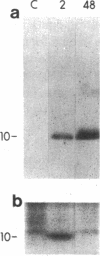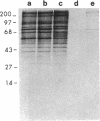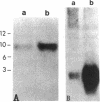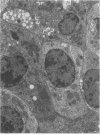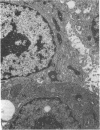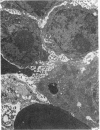Abstract
We studied the mechanisms by which excess copper exerts, and zinc mitigates, toxic effects on HepG2 cells. Survival and cell growth were reduced in media containing greater than 500 microM copper chloride for 48 h; LD50 was 750 microM. At 1,000 microM copper for 1 h, there was a general reduction of protein synthesis, and no recognizable changes in cellular ultrastructure. Incubation of cells with 200 microM zinc acetate before exposure to copper, raised the LD50 for confluent cells to 1,250 microM copper chloride, improved protein synthesis, and increased synthesis of a 10-kD protein, apparently metallothionein. The mitigation, by zinc, of copper's toxicity may in part be mediated through induction of this protein in the hepatocyte.
Full text
PDF


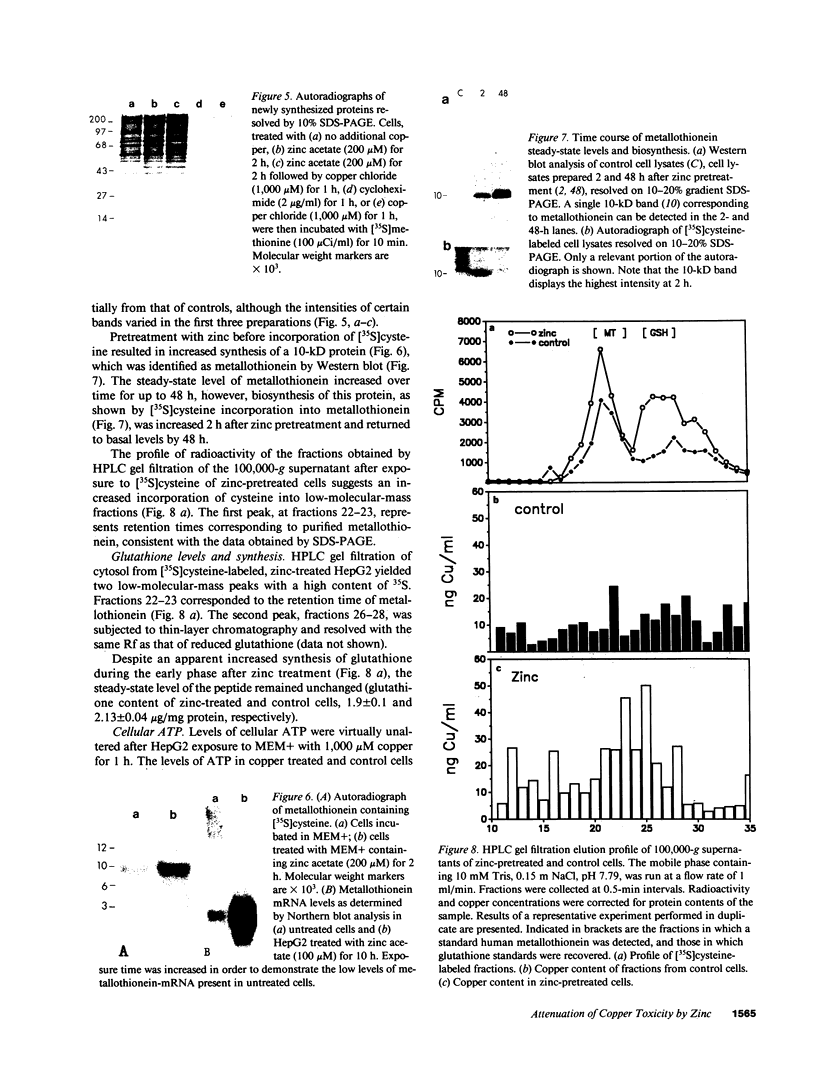



Images in this article
Selected References
These references are in PubMed. This may not be the complete list of references from this article.
- BOYSE E. A., OLD L. J., CHOUROULINKOV I. CYTOTOXIC TEST FOR DEMONSTRATION OF MOUSE ANTIBODY. Methods Med Res. 1964;10:39–47. [PubMed] [Google Scholar]
- Biempica L., Rauch H., Quintana N., Sternlieb I. Morphologic and chemical studies on a murine mutation (toxic milk mice) resulting in hepatic copper toxicosis. Lab Invest. 1988 Oct;59(4):500–508. [PubMed] [Google Scholar]
- Chirgwin J. M., Przybyla A. E., MacDonald R. J., Rutter W. J. Isolation of biologically active ribonucleic acid from sources enriched in ribonuclease. Biochemistry. 1979 Nov 27;18(24):5294–5299. doi: 10.1021/bi00591a005. [DOI] [PubMed] [Google Scholar]
- Cousins R. J. Absorption, transport, and hepatic metabolism of copper and zinc: special reference to metallothionein and ceruloplasmin. Physiol Rev. 1985 Apr;65(2):238–309. doi: 10.1152/physrev.1985.65.2.238. [DOI] [PubMed] [Google Scholar]
- Durnam D. M., Palmiter R. D. Induction of metallothionein-I mRNA in cultured cells by heavy metals and iodoacetate: evidence for gratuitous inducers. Mol Cell Biol. 1984 Mar;4(3):484–491. doi: 10.1128/mcb.4.3.484. [DOI] [PMC free article] [PubMed] [Google Scholar]
- Freedman J. H., Ciriolo M. R., Peisach J. The role of glutathione in copper metabolism and toxicity. J Biol Chem. 1989 Apr 5;264(10):5598–5605. [PubMed] [Google Scholar]
- Freedman J. H., Weiner R. J., Peisach J. Resistance to copper toxicity of cultured hepatoma cells. Characterization of resistant cell lines. J Biol Chem. 1986 Sep 5;261(25):11840–11848. [PubMed] [Google Scholar]
- Hanaichi T., Kidokoro R., Hayashi H., Sakamoto N. Electron probe X-ray analysis on human hepatocellular lysosomes with copper deposits: copper binding to a thiol-protein in lysosomes. Lab Invest. 1984 Nov;51(5):592–597. [PubMed] [Google Scholar]
- Hernandez O., Ballesteros L. M., Domingo Mendez J., Rosado A. Copper as a dissociating agent of liver and endometrial polysomes. Fertil Steril. 1974 Feb;25(2):108–112. doi: 10.1016/s0015-0282(16)40209-8. [DOI] [PubMed] [Google Scholar]
- Hill G. M., Brewer G. J., Prasad A. S., Hydrick C. R., Hartmann D. E. Treatment of Wilson's disease with zinc. I. Oral zinc therapy regimens. Hepatology. 1987 May-Jun;7(3):522–528. doi: 10.1002/hep.1840070318. [DOI] [PubMed] [Google Scholar]
- Hoogenraad T. U., Van Hattum J., Van den Hamer C. J. Management of Wilson's disease with zinc sulphate. Experience in a series of 27 patients. J Neurol Sci. 1987 Feb;77(2-3):137–146. doi: 10.1016/0022-510x(87)90116-x. [DOI] [PubMed] [Google Scholar]
- Hurst R., Schatz J. R., Matts R. L. Inhibition of rabbit reticulocyte lysate protein synthesis by heavy metal ions involves the phosphorylation of the alpha-subunit of the eukaryotic initiation factor 2. J Biol Chem. 1987 Nov 25;262(33):15939–15945. [PubMed] [Google Scholar]
- Janssens A. R., Bosman F. T., Ruiter D. J., Van den Hamer C. J. Immunohistochemical demonstration of the cytoplasmic copper-associated protein in the liver in primary biliary cirrhosis: its identification as metallothionein. Liver. 1984 Apr;4(2):139–147. doi: 10.1111/j.1600-0676.1984.tb00919.x. [DOI] [PubMed] [Google Scholar]
- Johnson G. F., Morell A. G., Stockert R. J., Sternlieb I. Hepatic lysosomal copper protein in dogs with an inherited copper toxicosis. Hepatology. 1981 May-Jun;1(3):243–248. doi: 10.1002/hep.1840010309. [DOI] [PubMed] [Google Scholar]
- Knowles B. B., Howe C. C., Aden D. P. Human hepatocellular carcinoma cell lines secrete the major plasma proteins and hepatitis B surface antigen. Science. 1980 Jul 25;209(4455):497–499. doi: 10.1126/science.6248960. [DOI] [PubMed] [Google Scholar]
- LOWRY O. H., ROSEBROUGH N. J., FARR A. L., RANDALL R. J. Protein measurement with the Folin phenol reagent. J Biol Chem. 1951 Nov;193(1):265–275. [PubMed] [Google Scholar]
- Lawn R. M., Adelman J., Bock S. C., Franke A. E., Houck C. M., Najarian R. C., Seeburg P. H., Wion K. L. The sequence of human serum albumin cDNA and its expression in E. coli. Nucleic Acids Res. 1981 Nov 25;9(22):6103–6114. doi: 10.1093/nar/9.22.6103. [DOI] [PMC free article] [PubMed] [Google Scholar]
- Lerch K., Johnson G. F., Grushoff P. S., Sternlieb I. Canine hepatic lysosomal copper protein: identification as metallothionein. Arch Biochem Biophys. 1985 Nov 15;243(1):108–114. doi: 10.1016/0003-9861(85)90778-7. [DOI] [PubMed] [Google Scholar]
- Meister A. Glutathione metabolism and its selective modification. J Biol Chem. 1988 Nov 25;263(33):17205–17208. [PubMed] [Google Scholar]
- Nartey N. O., Frei J. V., Cherian M. G. Hepatic copper and metallothionein distribution in Wilson's disease (hepatolenticular degeneration). Lab Invest. 1987 Oct;57(4):397–401. [PubMed] [Google Scholar]
- Samuelson A. C., Stockert R. J., Novikoff A. B., Novikoff P. M., Saez J. C., Spray D. C., Wolkoff A. W. Influence of cytosolic pH on receptor-mediated endocytosis of asialoorosomucoid. Am J Physiol. 1988 Jun;254(6 Pt 1):C829–C838. doi: 10.1152/ajpcell.1988.254.6.C829. [DOI] [PubMed] [Google Scholar]
- Sasa A., Hayashi H., Yagi A., Ohguchi S., Kidokoro R., Sato Y., Sakamoto N. A copper-sulfur complex in the liver of a patient with Wilson's disease. Gastroenterol Jpn. 1986 Dec;21(6):633–637. doi: 10.1007/BF02774493. [DOI] [PubMed] [Google Scholar]
- Schmidt C. J., Hamer D. H., McBride O. W. Chromosomal location of human metallothionein genes: implications for Menkes' disease. Science. 1984 Jun 8;224(4653):1104–1106. doi: 10.1126/science.6719135. [DOI] [PubMed] [Google Scholar]
- Sekine T., Ando K., Machida M., Kanaoka Y. Fluorescent thiol reagents. V. Microfluorometry of thiol compounds with a fluorescent-labeled maleimide. Anal Biochem. 1972 Aug;48(2):557–568. doi: 10.1016/0003-2697(72)90111-x. [DOI] [PubMed] [Google Scholar]
- Sternlieb I. Copper and the liver. Gastroenterology. 1980 Jun;78(6):1615–1628. [PubMed] [Google Scholar]
- Stockert R. J., Grushoff P. S., Morell A. G., Bentley G. E., O'Brien H. A., Scheinberg I. H., Sternlieb I. Transport and intracellular distribution of copper in a human hepatoblastoma cell line, HepG2. Hepatology. 1986 Jan-Feb;6(1):60–64. doi: 10.1002/hep.1840060112. [DOI] [PubMed] [Google Scholar]
- Towbin H., Staehelin T., Gordon J. Electrophoretic transfer of proteins from polyacrylamide gels to nitrocellulose sheets: procedure and some applications. Proc Natl Acad Sci U S A. 1979 Sep;76(9):4350–4354. doi: 10.1073/pnas.76.9.4350. [DOI] [PMC free article] [PubMed] [Google Scholar]
- Twedt D. C., Sternlieb I., Gilbertson S. R. Clinical, morphologic, and chemical studies on copper toxicosis of Bedlington Terriers. J Am Vet Med Assoc. 1979 Aug 1;175(3):269–275. [PubMed] [Google Scholar]
- Zern M. A., Leo M. A., Giambrone M. A., Lieber C. S. Increased type I procollagen mRNA levels and in vitro protein synthesis in the baboon model of chronic alcoholic liver disease. Gastroenterology. 1985 Nov;89(5):1123–1131. doi: 10.1016/0016-5085(85)90219-7. [DOI] [PubMed] [Google Scholar]



